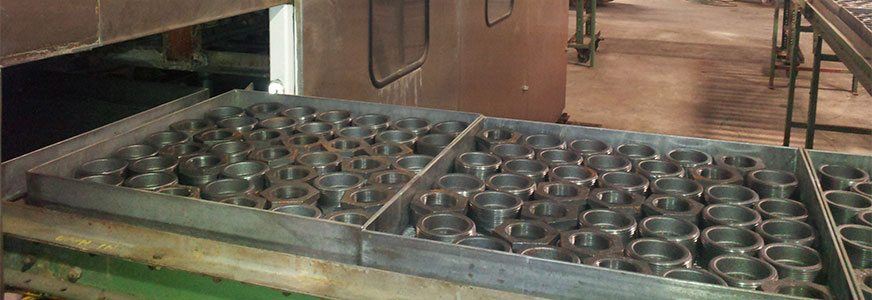Are you looking for a high-precision cleaning process to rid your parts of the most stubborn contaminants? Sharretts Plating Company, a metal finishing industry innovator for more than 80 years, now offers ultrasonic parts cleaning as part of our comprehensive offering of metal finishing services. Ultrasonic cleaning makes use of immersion and high-frequency sound waves to create a powerful, deep-penetrating cleaning process that removes contaminants including dirt, oil and grease. Ultrasonic cleaning can reach the tight spaces that other cleaning processes often miss.

The Ultrasonic Cleaning Process
The first stage of the ultrasonic cleaning process is the prewash that removes the bulk of the oil and other contaminants. The immersed materials then undergo an ultrasonic wash, in which high-frequency sound waves produce an intense microscopic scrubbing action at the surface that removes the remaining debris from the materials. Finally, the materials are moved to a working zone within the system that rinses them using a dual-stroke oscillation process. The stroke ranges can be adjusted to provide a more thorough cleaning process if necessary.
Benefits of Ultrasonic Cleaning
The microscopic cleaning capabilities of ultrasonic cleaning makes it especially effective for cleaning metal parts. Ultrasonic cleaning systems can clean inside holes smaller than the width of a human hair, which other processes such as spraying cannot duplicate. In addition, the process can clean the inside of tubing, injection mold gas cavities, carburetors and similar components with greater efficiency than other technologies. The ultrasonic energy can pass through the walls of many types of materials to stimulate the cavitation process for liquid cleaning solutions that are located deep within the substrate.
Request a free quote
For Ultra Sonic Washers
SPC Utilizes Superior Ultrasonic Cleaning Equipment
Just as SPC makes use of state-of-the art electroplating equipment, we also have access to cutting-edge ultrasonic cleaning machinery to ensure the most effective cleaning process possible. We make use of industrial strength consoles that are specifically designed to meet the unique challenges of the production process, regardless of volume or complexity. As a result, we are able to complete your ultrasonic cleaning task with maximum speed and efficiency. A typical ultrasonic cleaning cycle takes only a matter of minutes.
A Cleaning Process that Is Safe for the Environment
Eco-friendly companies are happy to learn that SPC's ultrasonic cleaning process is a more palatable alternative to potentially harmful chemical solvents that can be released into the environment. The shorter cleaning cycle also requires less energy than other cleaning processes. In short, ultrasonic cleaning is a non-destructive process that sacrifices nothing when it comes to the quality of the results.
Sharretts Plating Company Is Your Ultrasonic Cleaning Resource
Whether we are providing electroplating, ultrasonic cleaning or any of the other metal finishing services we offer, you can count on our customer-focused business approach that is designed to help you in your quest for business improvement. Our goal is to achieve total customer satisfaction for every company we have the privilege to serve.
Ultrasonic washing process and produce
The following tips can optimize the ultrasonic washing process and produce the best possible cleaning results for your parts:
Choose the Right Cleaning Solution for Application
The cleaning solution you use for your ultrasonic cleaning process should be suitable for the type of metal and nature of the contaminants you are dealing with. For instance, an alkaline soap with a relatively high pH level can remove dirt, oil or grease from a soft metal such as aluminum. However, if the pH is too high, it could damage the parts. An alkaline soap with a high pH level can also be used to clean harder metals such as steel and titanium, but it is a good idea to choose a soap containing a built-in rust inhibitor to prevent the onset of corrosion.
Select the Most Appropriate Temperature
The temperature of the bath will have a direct impact on cleaning results. For normal ultrasonic washing applications, the ideal temperature range is between 135 and 150 F a temperature below this range will not produce the desired cleaning action, while a higher temperature could cause the chemistry of the cleaning solution to break down or damage the parts. When washing fragile parts, setting the temperature towards the lower end of the scale and lengthening the duration of the cleaning process can usually deliver the best results.
Power Considerations
The size of the ultrasonic cleaning tank, the type of parts and the degree of contamination all have an impact on the watt density that should be used (the measure of the level of ultrasonic power vs. liquid volume in the tank). As a general rule, parts with lower levels of contamination require a lower watt density than bulky, heavily-soiled parts. As far as output frequency, 40 kHz works best for most cleaning applications. A higher frequency can produce smaller scrubbing bubbles, which are ideal for cleaning microscopic debris. Conversely, a lower frequency results in larger, more powerful bubbles for effective cleaning of heavy parts.
Learn More About Ultrasonic Cleaning from SPC
We invite you to contact us to learn more about our ultrasonic cleaning process or to receive your no-obligation price quote today!
LEARN WHAT OUR MANY SATISFIED CUSTOMERS HAVE TO SAY ABOUT Us
"I would like to thank you for the help you have provided us in developing an electroless nickel plating technique on an unusual substrate. The sample platings you provided show that we should be able to reach our goals. I especially appreciate your willingness to take on an unusual job, with the uncertainties that that entails...We are looking forward to working with you in the future on our plating needs."
– Robert K.



